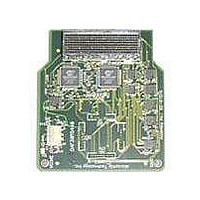DAF30-3 Microchip Technology, DAF30-3 Datasheet - Page 2

DAF30-3
Manufacturer Part Number
DAF30-3
Description
DEVICE ATP FOR ICE4000
Manufacturer
Microchip Technology
Specifications of DAF30-3
Module/board Type
*
Processor To Be Evaluated
dsPIC30F
Lead Free Status / RoHS Status
Lead free / RoHS Compliant
For Use With/related Products
ICE4000
For Use With
PMF30XA1 - PROCESSOR MODULE FOR ICE4000
Lead Free Status / RoHS Status
Lead free / RoHS Compliant, Lead free / RoHS Compliant
Other names
DAF30-3R
DAF30-3R
DAF30-3R
MPLAB
2.4
Once the processor module is inserted into the emula-
tor pod, the flex circuit cable extends the emulator
system to the target application.
Emulator analog functions may not operate within the
performance specifications published in the device
data sheet due to parasitic capacitance (up to 120 pf)
of the flex cable.
2.5
The device adapter provides a common interface for
the device being emulated. It is provided in standard
DIP and transition socket styles for other packages.
The adapter also contains a special device that
provides an oscillator clock to accurately emulate the
oscillator characteristics of the PICmicro MCU.
Due to components on the device adapter, which
require target power, the device adapter should be
removed from the flex circuit cable (see Figure 2-1)
when emulator power is being used and the processor
module is not connected to the target. This will
eliminate any loading effects on I/O pins.
2.6
Transition sockets are available in various styles to
allow a common device adapter to be connected to one
of the supported surface mount package styles.
Transition sockets are available for various pin counts
and pitches for PLCC, SOIC, QFP, QFN and other
styles. For more information on transition sockets,
see the MPLAB ICE 2000/4000 Transition Socket
Specification (DS51194).
3.0
General limitations that apply to the MPLAB ICE 4000
emulator may be found in the on-line help. Select
Help>Topics and then select “MPLAB ICE 4000” under
“Debuggers”.
Device-specific limitations can be found as above or by
selecting Debugger>Settings, clicking the Limitations
tab, and then clicking the Details button.
DS51298E-page 2
Flex Circuit Cable
Device Adapter
Transition Socket
EMULATOR-RELATED ISSUES
®
ICE 4000
Preliminary
4.0
Processor modules are identified on the top of the
assembly (e.g., PMF18WA0). To determine which
processors are supported by a specific module, refer to
the file “Readme for MPLAB ICE 4000.txt” in the
MPLAB IDE installation directory or the latest Product
Selector Guide (DS00148), which can be found on the
Microchip web site at www.microchip.com.
A typical processor module contains a special
bond-out version of a PICmicro MCU or dsPIC DSC,
device buffers to control data flow and control logic. It
provides the means of configuring the MPLAB ICE
4000 emulator for a specific device family and handles
low-voltage emulation when needed.
4.1
The operating voltage for most of the control logic and
buffering on the processor module is supplied by the
emulator pod. Power to the emulator processor and
some of its surrounding buffers is user-selectable, and
can be powered by the emulator pod (at +5V only) or
the target application system (from 2.0V to 5.5V). This
is software selectable and is configurable through the
MPLAB IDE software. At no time will the emulator
system directly power the target application system.
ALWAYS insert the processor module into the emulator
pod before applying power to the pod.
When connecting to a target application system, there
may be a voltage level on the target application even
though power has not yet been applied to the target
application circuit. This is normal, and is due to current
leakage through V
leakage will typically be less than 20 mA. However, if
the target application is using a voltage regulator, it
should be noted that some regulators require the use of
an external shunt diode between V
reverse-bias protection. Refer to the manufacturer’s
data sheets for additional information.
4.1.1
If the emulator system is selected to power the
emulator processor in the processor module, the
emulator system can be operated without being
connected to a target application. If the system is being
connected to a target application, the power to the pod
should be applied before applying power to the target
application.
The target application system’s V
small current load (10 mA typical) when the emulator
system is connected via a device adapter. This is
because the target system must always power the
clock chip in the device adapter.
PROCESSOR MODULES
Power
EMULATOR PROCESSOR POWER
SUPPLIED BY EMULATOR SYSTEM
CC
of the device adapter. The current
© 2005 Microchip Technology Inc.
CC
will experience a
IN
and V
OUT
for












